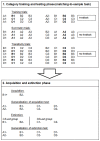Generalization of human fear acquisition and extinction within a novel arbitrary stimulus category
- PMID: 24798047
- PMCID: PMC4010469
- DOI: 10.1371/journal.pone.0096569
Generalization of human fear acquisition and extinction within a novel arbitrary stimulus category
Abstract
Adaptive anxiety relies on a balance between the generalization of fear acquisition and fear extinction. Research on fear (extinction) generalization has focused mostly on perceptual similarity, thereby ignoring the importance of conceptual stimulus relations in humans. The present study used a laboratory procedure to create de novo conceptual categories of arbitrary stimuli and investigated fear and extinction generalization among these stimuli. A matching-to-sample task produced two four-member categories of abstract figures. Next, a member from one category was coupled with an aversive electrical stimulation, while a member from the other category was presented alone. As expected, conditioned fear responses generalized to the other members of the first category (skin conductance and online shock-expectancy). Subsequent extinction of the conditioned member also generalized to the other members. However, extinguishing a non-conditioned member failed to reduce fear of the conditioned member itself. We conclude that fears generalize readily across conceptually related stimuli, but that the degree of extinction generalization depends on the stimulus subjected to extinction.
Conflict of interest statement
Figures






Similar articles
-
Generalization and Extinction of Concept-BasedPain-Related Fear.J Pain. 2019 Mar;20(3):325-338. doi: 10.1016/j.jpain.2018.09.010. Epub 2018 Oct 6. J Pain. 2019. PMID: 30296613
-
Supporting extinction memory updating to promote extinction generalization in a category-based fear conditioning paradigm.Behav Res Ther. 2025 May;188:104719. doi: 10.1016/j.brat.2025.104719. Epub 2025 Mar 15. Behav Res Ther. 2025. PMID: 40120227
-
Fear generalization in humans: impact of feature learning on conditioning and extinction.Neurobiol Learn Mem. 2014 Sep;113:143-8. doi: 10.1016/j.nlm.2013.10.002. Epub 2013 Oct 9. Neurobiol Learn Mem. 2014. PMID: 24120427
-
Spreading the reduction of fear: A narrative review of generalization of extinction learning in human fear conditioning.Clin Psychol Rev. 2025 Jun;118:102580. doi: 10.1016/j.cpr.2025.102580. Epub 2025 Apr 1. Clin Psychol Rev. 2025. PMID: 40184732 Review.
-
Novel approaches for strengthening human fear extinction: The roles of novelty, additional USs, and additional GSs.Behav Res Ther. 2020 Jan;124:103529. doi: 10.1016/j.brat.2019.103529. Epub 2019 Dec 5. Behav Res Ther. 2020. PMID: 31865236 Review.
Cited by
-
Neural correlates of conceptual-level fear generalization in posttraumatic stress disorder.Neuropsychopharmacology. 2020 Jul;45(8):1380-1389. doi: 10.1038/s41386-020-0661-8. Epub 2020 Mar 28. Neuropsychopharmacology. 2020. PMID: 32222725 Free PMC article.
-
Laboratory models of post-traumatic stress disorder: The elusive bridge to translation.Neuron. 2022 Jun 1;110(11):1754-1776. doi: 10.1016/j.neuron.2022.03.001. Epub 2022 Mar 23. Neuron. 2022. PMID: 35325617 Free PMC article. Review.
-
Related to Anxiety: Arbitrarily Applicable Relational Responding and Experimental Psychopathology Research on Fear and Avoidance.Perspect Behav Sci. 2017 Dec 27;41(1):189-213. doi: 10.1007/s40614-017-0133-6. eCollection 2018 Jun. Perspect Behav Sci. 2017. PMID: 32004365 Free PMC article.
-
Modification of Fear Memory by Pharmacological and Behavioural Interventions during Reconsolidation.PLoS One. 2016 Aug 18;11(8):e0161044. doi: 10.1371/journal.pone.0161044. eCollection 2016. PLoS One. 2016. PMID: 27537364 Free PMC article. Clinical Trial.
-
From Extinction Learning to Anxiety Treatment: Mind the Gap.Brain Sci. 2019 Jul 11;9(7):164. doi: 10.3390/brainsci9070164. Brain Sci. 2019. PMID: 31336700 Free PMC article.
References
-
- Craske MG, Hermans D, Vansteenwegen D (2006) Fear and learning: From basic processes to clinical implications. Washington DC: American Psychological Association. 319 p. doi: 10.1037/11474-000.
-
- Hermans D, Baeyens F, Vervliet B (2013) Generalization of acquired emotional responses. In: Robinson MD, Watkins ER, Harmon-Jones E, editors. Handbook of cognition and emotion. New York: Guilford Press. pp. 117–134.
-
- Foa EB, Kozak MJ (1986) Emotional processing of fear: exposure to corrective information. Psychol Bull 99: 20–35 10.1037/0033-2909.99.1.20.. - PubMed
Publication types
MeSH terms
LinkOut - more resources
Full Text Sources
Other Literature Sources
Research Materials

